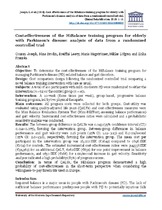| dc.contributor.author | Joseph, Conran | |
| dc.contributor.author | Brodin, Nina | |
| dc.contributor.author | Leavy, Breiffni | |
| dc.contributor.author | Hagstromer, Maria | |
| dc.contributor.author | Lofgren, Niklas | |
| dc.contributor.author | Franzén, Erika | |
| dc.date.accessioned | 2018-10-01T09:17:16Z | |
| dc.date.available | 2018-10-01T09:17:16Z | |
| dc.date.issued | 2018 | |
| dc.identifier.citation | Joseph, C. et al. (2018). Cost-effectiveness of the HiBalance training program for elderly with Parkinson’s disease: analysis of data from a randomized controlled trial. Clinical Rehabilitation, 2018: 1-11. | en_US |
| dc.identifier.issn | 0269-2155 | |
| dc.identifier.uri | http://dx.doi.org/10.1177/0269215518800832 | |
| dc.identifier.uri | http://hdl.handle.net/10566/4078 | |
| dc.description.abstract | OBJECTIVE: To determine the cost-effectiveness of the HiBalance training program for managing Parkinson’s disease (PD)-related balance and gait disorders.
DESIGN: Cost comparison design following the randomized controlled trial comparing a novel balance training intervention with care as usual.
SUBJECTS: A total of 100 participants with mild–moderate PD were randomized to either the intervention (n = 51) or the control group (n = 49).
INTERVENTION: A 10-week (three times per week), group-based, progressive balance training program, led by two physical therapists.
MAIN OUTCOMES: All program costs were collected for both groups. Cost-utility was evaluated using quality-adjusted life years (QALYs) and cost-effectiveness measures were the Mini Balance Evaluation Systems Test (Mini-BESTest; assessing balance performance) and gait velocity. Incremental cost-effectiveness ratios were calculated and a probabilistic sensitivity analysis was conducted.
RESULTS: The between-group difference in QALYs was 0.043 (95% confidence interval (CI): 0.011–0.075), favoring the intervention group. Between-group differences in balance performance and gait velocity were 2.16 points (95% CI: 1.19–3.13) and 8.2 cm/second (95% CI: 2.9–13.6), respectively, favoring the intervention group. The mean cost per participant in the intervention group was 16,222 SEK (€1649) compared to 2696 SEK (€274) for controls. The estimated incremental cost-effectiveness ratios were 314,558 SEK (€31,969) for an additional QALY, 6262 SEK (€631) for one point improvement in balance performance, and 1650 SEK (€166) for 1 cm/second increase in gait velocity. Sensitivity analyses indicated a high probability (85%) of program success.
CONCLUSION: In terms of QALYs, the HiBalance program demonstrated a high probability of cost-effectiveness in the short-term perspective when considering the willingness-to-pay thresholds used in Europe. | en_US |
| dc.language.iso | en | en_US |
| dc.publisher | SAGE Publications | en_US |
| dc.rights | This is the author-version of the article published online at: http://dx.doi.org/10.1177/0269215518800832 | |
| dc.subject | Parkinson’s disease | en_US |
| dc.subject | HiBalance training | en_US |
| dc.subject | Cost-effectiveness | en_US |
| dc.subject | Economic evaluation | en_US |
| dc.subject | Quality-adjusted life years | en_US |
| dc.title | Cost-effectiveness of the HiBalance training program for elderly with Parkinson’s disease: analysis of data from a randomized controlled trial | en_US |
| dc.type | Article | en_US |
| dc.privacy.showsubmitter | FALSE | |
| dc.status.ispeerreviewed | TRUE | |

